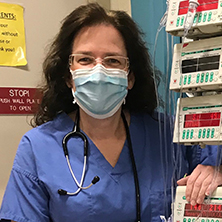D.N.P. Scholarly Projects

Alcohol Screening and Brief Intervention Program in a University Health Service Inappropriate alcohol consumption poses an enormous threat to the physical, social,
and economic well-being of the American public. Young adults, specifically college
students, are at particularly high risk for alcohol misuse. Students who visit Seton
Hall University Health Services for routine health care are an ideal group to engage
in alcohol screening and education. The purpose of this project is to introduce and
evaluate an alcohol screening and brief intervention program in a college health center
in an effort to raise awareness, provide information and offer strategies for cutting
down on alcohol misuse to students who are at risk for hazardous drinking behaviors.

Implementation of an Opioid Risk Assessment Tool
The increased prevalence of opioid use in society has led to an increase in surgical
patients with a history of such use. Patients who use or are addicted to opioids have
different tolerances and responses to anesthesia than non-opioid users and will require
different care than non-users both pre- and post-operatively. The means to identify
this population prior to a surgical procedure is needed as a way to organize, plan
and manage patient care during the perioperative period. An Opioid Risk Assessment
Tool (ORAT) was used as a way to streamline the process of identifying these patients.
This paper addresses the development, implementation and execution of this quality
improvement project, along with the screening results of pre-surgical patients.

An APN led COPD Discharge Education Program to Decrease 30-Day Readmission Rates he purpose of this project was to implement an APN-led COPD discharge education program
to decrease 30-day readmission rates. This DNP project combined strategies obtained
in the literature search and blended these into a cutting-edge and state-of-the-art
discharge education program at a major medical center. The significance of chronic
obstructive pulmonary disease (COPD) readmission rates include financial implications,
a large number of Medicare patients who return to the hospital within 30 days, poor
quality of patient care, and poorly coordinated discharge processes.
Viktoryia Fridman
The Effectiveness of Nurse-Driven Early Mobility Protocol
The purpose of this quality initiative is to introduce the nurse-driven evidence-based
practice change related to patient mobility in the hospital setting with the aim to
improve nurse knowledge, attitude, and behavior on a medical-surgical unit. The proposed
DNP quality project is devised from the American Academy of Nursing (AAN) Choosing
Wisely campaign unique to the elements of "don't let older adults lay in bed or only
get up to a chair during their hospital stay" to achieve a practice change.
Eunide Joseph
Promoting Newborn Skin-to-Skin Contact to Increase Breastfeeding Initiation and Exclusivity
in Cesarean Deliveries
Literature has documented when a mother elects to breastfeed, she offers herself and
her baby with many short and long-term wellness and health benefits. Therefore, maternal
child healthcare providers should be prompted to scale up breastfeeding practices
that promote lactation. Skin-to-skin contact (SSC) is underutilized, yet a cost-effective
incentive to promote successful breastfeeding. Traditional postnatal assessments lead
to the precipitous disconnect of the mother-baby dyad resulting in delayed SSC and
breastfeeding initiation. To promote early newborn maternal and/or paternal SSC through
nursing education and clinical practice poster reminder to increase breastfeeding
initiation and the at discharge exclusivity rate in uncomplicated cesarean deliveries.
Benson Kahiu
Implementation of Change of Shift Huddles in an Urban Medical Center
Since 1999 when the Institute of Medicine (IOM) highlighted medical errors in hospitals,
healthcare leaders continue to pursue relevant and sustainable patient safety initiatives.
Some of these initiatives include projects that increase accountability while encouraging
enhanced teamwork and communication between team members. The lack of consistent communication
results in decreased patient outcomes and patient dissatisfaction. Decreased camaraderie
in organizations, results in fiscal waste associated with employee tardiness and callouts.
This paper reviews the process and impact of implementing change of shift huddles
in an urban medical center.
-
Maureen Byrnes
Implementing a mHealth program within a homeless population of young mothers -
Ekaterina Boutos
Improving Health Outcomes and Lifestyle Choices in an Underserved Community through the Implementation of a Wellness Program -
Colleen Carrington
Perinatal Health Education Intervention Program for Adolescent and Young Adult Pregnant Homeless Women Living in Transitional Housing
Best Practice Teaching Intervention Program for Staff Responsible for Care of the Mother-Baby Dyad -
Katherine Connolly
A Quality Improvement Initiative Aimed at Reducing Complications Related to IV Fluid Administration in the Acute Care Setting -
Cecilia Cortina
Safety Culture and Fall Prevention: A Collaborative Effort -
Rebecca Couper
Watchful Waiting and Antibiotic Stewardship: A quality Improvement Project -
Linda D’Antonio
Quality Improvement Initiative Aimed at Reducing Catheter-associated Infections in the Surgical Setting -
Marie A. Fagan
Early Prevention of Pressure Ulcers in the Emergency Department -
Shantha Franks
Transitional Care To Reduce 30-Day Heart Failure Readmissions Among The Long-Term Care Elderly Population -
Seana Friedman
Can Standardizing Clinical Management Through CABG Clinical Pathways Reduce the LOS of CABG Patients, Increase Patient Satisfaction and Decrease Hospital Acquired Infections? -
Lisa Maria Friedrich
Improving Patient Care Outcomes to Reduce Recurrent Admissions of Patients Discharged With Chronic Obstructive Pulmonary Disease -
Patricia Hansen
Antibiotic Resistance: Use of Delayed Prescriptions for Viral Syndromes in Urgent Care -
Ivonne Guzman
Caring for the Bereaved Mother -
Patricia Hubert
Implementation of Jean Watson’s Theory of Transpersonal Caring in a Pain Center -
Margaret Huryk
A Patient-Centered Care Staff Education Project in Long-Term Care to Reduce Behavioral and Psychological Symptoms of Dementia -
Patricia James
What are the Nurse’s Perception of the Effectiveness of the Electronic Go-Jo Monitoring System on Hand Hygiene Compliance and Hospital Acquired Infections? -
Benay Johnson
Increasing Neonatal Resuscitation Readiness -
Kathleen Livolsi
Implementing Delayed Bathing in Community Hospital Setting -
Mary McDermott
Debriefing with Good Judgment: Best Practice for Reflective Learning in Simulation in Pre-Licensure Nursing Education -
Luis Medina
Effects of an Alcohol Education Program on Improving Knowledge, Attitudes and Satisfaction of Registered Nurses Caring for Patients Undergoing Alcohol Withdrawal -
Patricia Clark Pappas
Implementation of a Wellness Program to Address Health Disparities in a Vulnerable Population -
Varsha Singh
Stroke Clinical Orders Pathway Education (SCOPE) for APNs -
Kristine Bayot Sparks
Initiating a Bystander awareness Program at a State University -
Stephen Stoever
Accuracy of RN Visual Quantification of Emesis Volumes in the Neonatal Intensive Care Unit -
Christine Tevlin
Competency Guide for Intrathecal Nurses -
Aileen T. Twomey
The Patient-Centered Medical Home Model: Maintaining Patient Focus, Meeting the Institute for Healthcare Improvement Triple Aim, and Incorporating the Electronic Medical Record -
Clare Wisor
Increasing Compliance of Bar Code Medication Administration in the Emergency Room
Apply Online Here
Begin or continue your online application.

